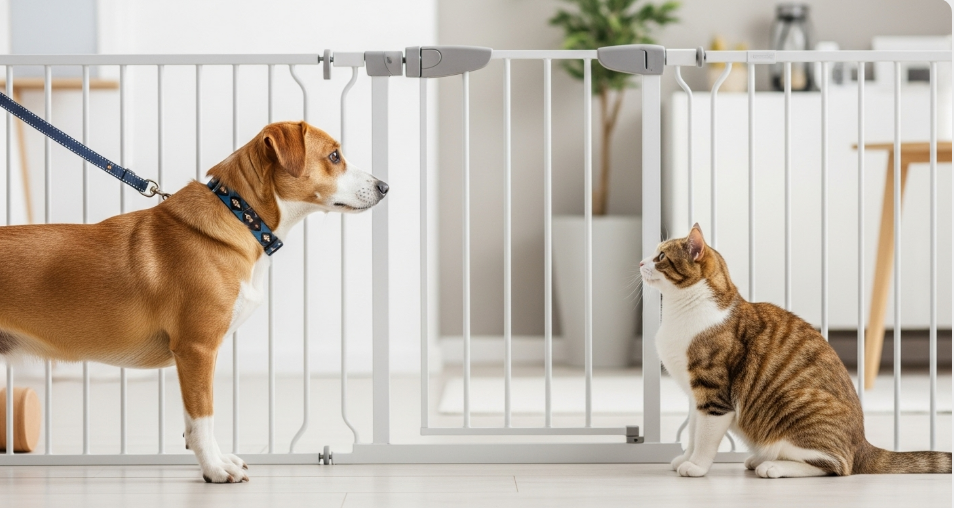Introducing a cat to a dog can be smooth with the right approach. Cats and dogs can live together peacefully, but it takes patience and planning. This guide provides clear, actionable steps to help your pets form a safe and happy bond. Follow these tips to ensure a stress-free introduction.
Why Proper Introductions Matter
Cats and dogs have different behaviors and instincts. Cats are territorial, while dogs may have a strong prey drive. A rushed introduction can lead to stress, fear, or aggression. Taking it slow helps both pets feel safe and builds trust. The goal is to create positive associations between them.
Key Considerations Before Starting
- Assess Personalities: Some cats are social, while others prefer solitude. Dogs with high prey drives may chase cats. Consult a professional trainer if your dog shows aggression toward cats.
- Health Checks: Ensure both pets are healthy. Quarantine a new pet for 3-4 days and visit a vet before introductions.
- Time and Patience: Introductions can take weeks or months. Progress at the pets’ pace to avoid stress.

Step-by-Step Guide to Introducing a Cat to a Dog
Step 1: Prepare a Safe Space for the Cat
Create a dog-free sanctuary for the cat. This room should include:
- A litter box
- Food and water bowls
- A scratching post
- Toys and a bed
- High perches or shelves for escape
Cat-proof the space by removing hazards like cords or toxic plants. This sanctuary allows the cat to feel secure and retreat if needed.
Learn more about creating a safe environment for your cat in our post on why cats knead.
Step 2: Scent Swapping
Before the pets meet, help them get used to each other’s scent:
- Stroke each pet without washing your hands to mix their scents.
- Swap bedding or toys between the cat and dog.
- Use a soft cloth to rub the new pet’s head and place it in common areas.
This step builds familiarity without direct contact. Allow a few days for scent swapping.
Step 3: Controlled Visual Introductions
Once both pets are comfortable with each other’s scent, start visual introductions:
- Use a baby gate or crack a door to let them see each other at a distance.
- Keep the dog on a loose leash to prevent chasing.
- Feed both pets high-value treats during these sessions to create positive associations.
- Keep sessions short (5-10 minutes) and stop if either pet shows stress.

Step 4: Face-to-Face Meetings
When both pets are calm during visual introductions, move to face-to-face meetings:
- Choose a neutral common area, not the cat’s sanctuary.
- Keep the dog on a leash, letting the cat move freely.
- Reward calm behavior with treats for both pets.
- End the session if either pet shows signs of stress, like hissing or barking.
Step 5: Gradual Freedom
As the pets grow comfortable, allow more freedom:
- Let the dog drag a leash in the room for quick control if needed.
- Ensure the cat has access to high perches or escape routes.
- Supervise closely and separate them when you’re not home.
Curious about other cat behaviors? Check out our post on how long cats are pregnant to understand feline needs better.
Step 6: Long-Term Supervision
Even if the pets get along, continue to monitor their interactions:
- Never leave them alone unsupervised until you’re certain they’re safe together.
- Watch for signs of stress, like a cat’s pinned ears or a dog’s intense staring.
- Consult a trainer if aggression persists.
Common Mistakes to Avoid
- Rushing the Process: Moving too fast can cause fear or fights.
- Ignoring Body Language: Watch for signs like a cat’s swishing tail or a dog’s stiff posture.
- Forcing Interaction: Let the cat approach the dog at its own pace.
- Neglecting Training: Teach the dog basic commands like “sit” or “leave it” to manage behavior.
How Long Does It Take?
The process can take anywhere from a few weeks to several months. Each pet is unique, and some may need more time to adjust. Progress isn’t always linear, so be patient and go back a step if needed.

People Also Ask
- Can all cats and dogs live together? Not every pair is compatible. Some dogs have a strong prey drive, and some cats are too territorial. A professional trainer can assess compatibility.
- What if my dog chases the cat? Keep the dog on a leash during introductions. If chasing persists, go back to earlier steps and consult a trainer.
- How do I know if my cat is stressed? Look for pinned ears, hissing, or a swishing tail. Provide a safe space and slow down the process if these signs appear.
- Can I introduce a kitten to a dog? Kittens may adapt faster but are more vulnerable. Follow the same steps and ensure the dog is gentle.
Final Tips for Success
- Always prioritize safety for both pets.
- Use positive reinforcement, like treats, to reward calm behavior.
- Be patient and let the pets set the pace.
- Seek professional help if you’re unsure or see aggression.
By following these steps, you can help your cat and dog build a peaceful relationship. Share your experiences with us at Petfel, and let us know how your pets are getting along!
